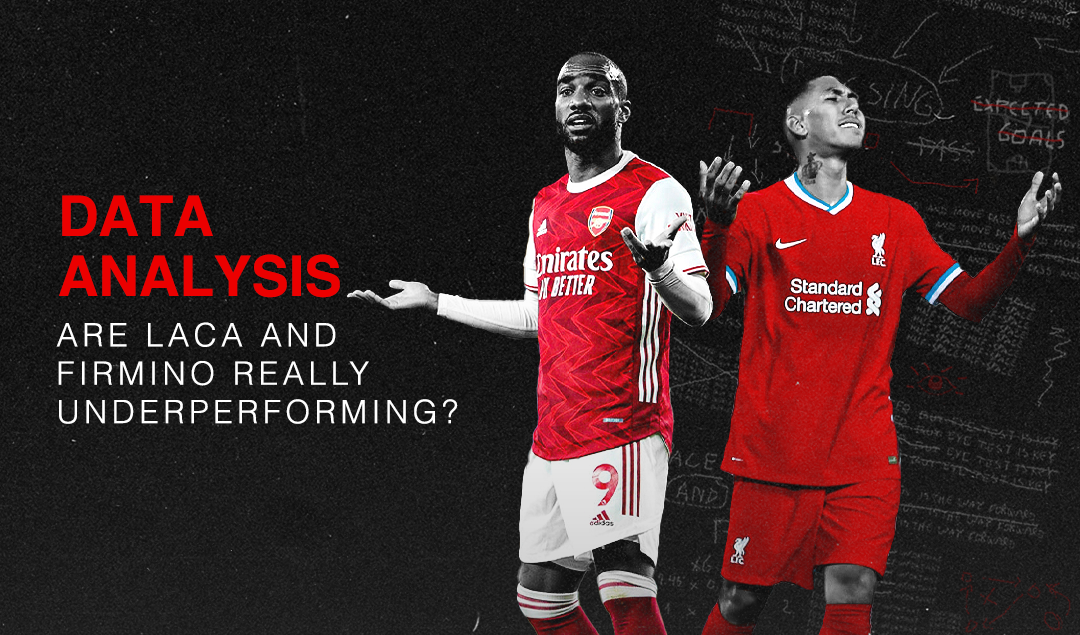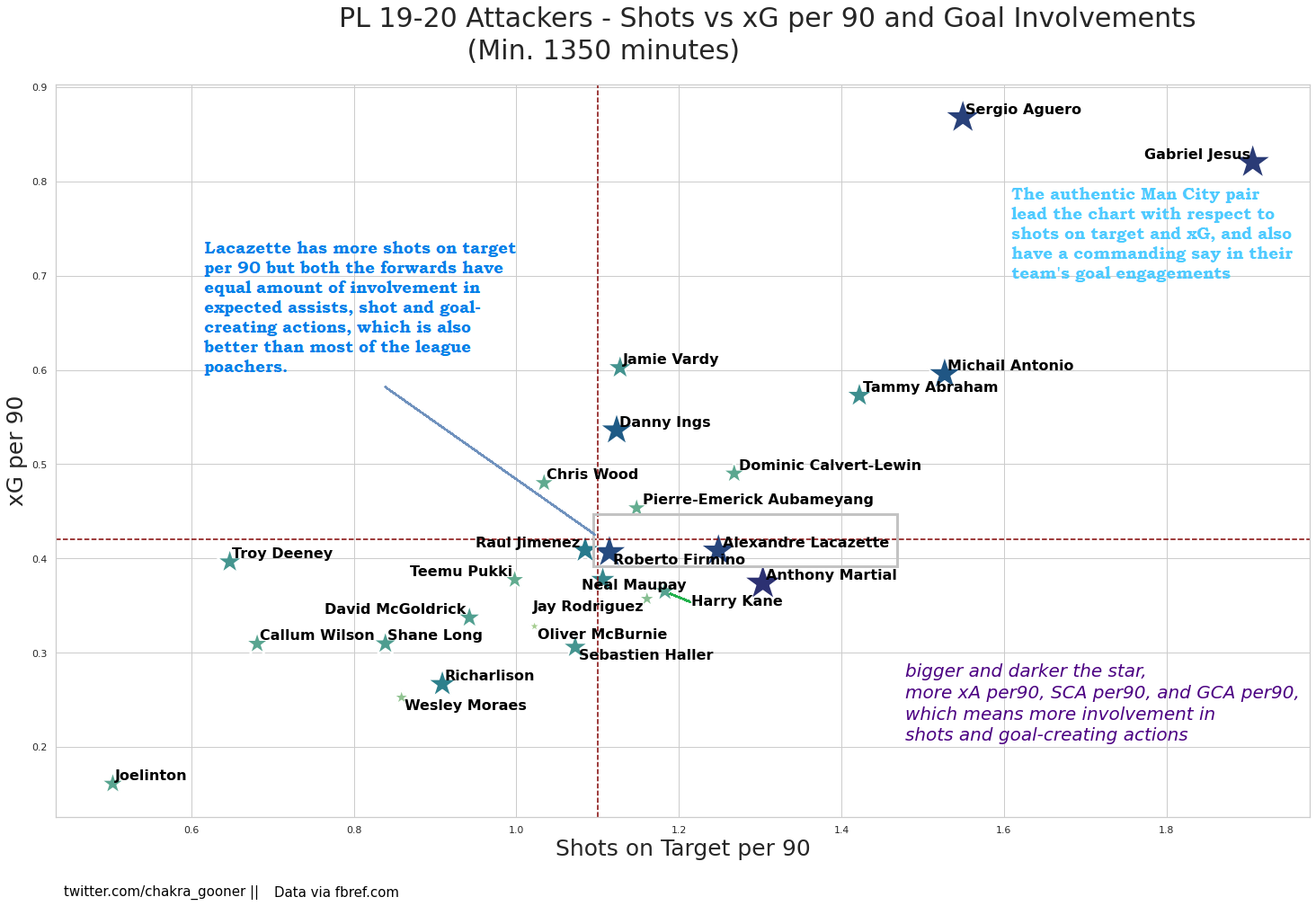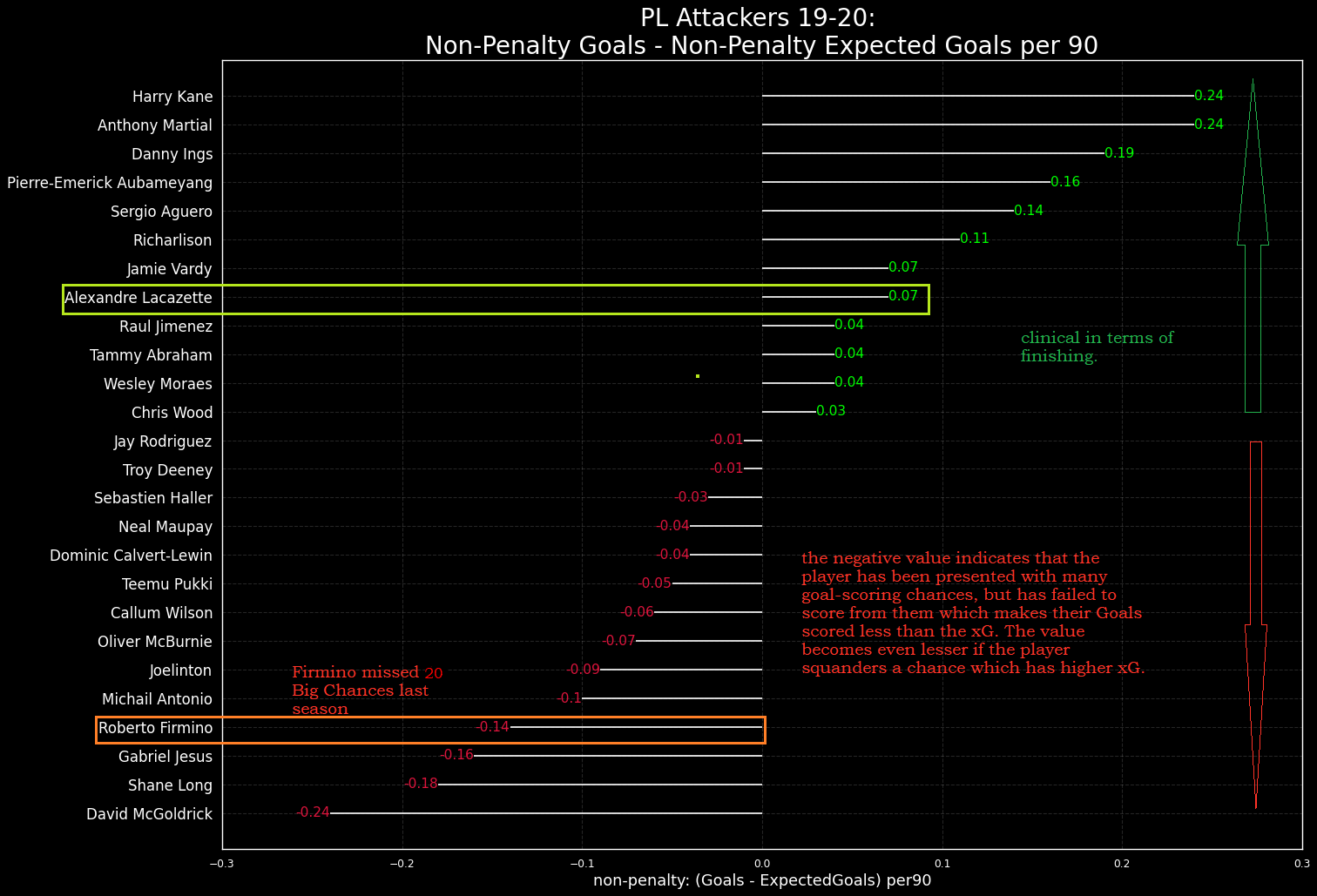Are Alexandre Lacazette and Roberto Firmino Really Underperforming ? A Comparison With the Other No 9’s in the Premier League
Recently, when Liverpool manager Jürgen Klopp was bombarded with questions on Roberto Firmino’s diminishing goal-scoring record, he said:
“I don’t have to say one word about Bobby Firmino and how important he is for us, I don’t waste time with that. He was in so many games the difference-maker without scoring maybe, I’m not sure, but with scoring as well in other games, so I would feel really embarrassed if I had to mention the qualities of him.”
Likewise, Arsenal manager Mikel Arteta was forced to defend his striker Alexandre Lacazette when the 2018-19 Arsenal’s Player of the Season went through a rough patch of games. He shed light on what the Frenchman brings aside from his goals and praised the striker’s hardworking nature. When asked if Lacazette could leave the club, he mentioned: “Why would I want to lose a player like him? I’m really happy with him.”
Both the strikers have come under the spotlight over the past year for not being impactful in terms of goals and assists and lacking the killer finish in front of the goal. Both were pilloried for failing to convert big chances, especially Lacazette, for squandering even the rare ones that came by Arsenal last season. But the reality is much different.
In modern football, the role of a central striker is more than just flicking on headers, being astute in the box for rebounds, and scoring penalties. Every team has evolved tactically, so has been the usage of the “No 9’s.” It is a known fact that tweaking the forward line by deploying different formations with and without the ball disrupts the opposition’s defensive line and this has been one of the weapons for most of the attacking teams nowadays.
Furthermore, involving their central strikers in build-up play has been an integral part, where adding that extra man in the attacking or middle 3rd not only brings physicality but also creates an extra option in those important zones for aiding progressive play.
So, have they both really underperformed? Let’s answer that by diving into the analysis by comparing the performance of the both the strikers with the other forwards from the recently concluded Premier League season.
To begin with, let us take a look at their direct goal contributions in the Premier League since Lacazette signed for the Gunners in the 2017 summer. We can straight away observe that Firmino’s contribution has taken a dip every year while the former Lyon forward has had mixed performances in his first 3 seasons. Despite Firmino playing 1000 minutes more than the Frenchman in their title-winning season, the Reds forward just managed just 3 more than Arsenal’s No 9 in terms of goal contributions.
These numbers might look insufficient for the qualities that they possess and the position they play, but is it only the goals and assists that determine their strengths? Absolutely not. There are a multitude of other metrics and qualities which need to be assessed to ascertain their performance. Let’s take a look at them and also compare how they stand among the other forwards in the league.
Note: Strikers who have played at least 1350 minutes (or 15 full 90 mins) have been considered for this analysis. Inside forwards, wingers, wide strikers and attacking midfielders have NOT been taken into consideration. Data source: StatsBomb via fbref.
Helping Their Team’s Build-up Play
Playing out from the back has become an increasingly popular way to dictate possession, and therefore, games. It is much easier to link up plays by playing short passes. Furthermore, with teams playing with high full-backs, inside forwards have started to exploit the half-spaces in the final third to provide more goal-scoring options.
Consequently, this has moved strikers into a deeper, tucked-in role where they can receive and protect the ball in tight situations, and provide through balls.
This above figure justifies why Firmino is protected so much by Klopp and some pundits still praise him. The former Hoffenheim man comfortably beats any other striker in the league in terms of attempted and completed passes per 90. These numbers might look crazy for a central striker but it’s his role as a deep-lying forward which he does to perfection. The Brazilian is known for his versatility in playing across the front line and that experience has made Klopp bring the best out of him.
The size and color of the bubble from the graph tell us how important a striker is in constructing progressive passes, key passes, and passes made into the opposition box (all per 90). Even though Arsenal’s number 9 lies in the first quadrant, he still needs to polish his progressive passing skills to be more effective.
While Lacazette’s willingness to receive the ball in deeper areas and involve in the hold-up play and distribute it has improved, Firmino has certainly set a high bar. It is not an easy job for a pure poacher like Lacazette to convert into an unconventional striker who engineers key passes and provides through balls. But with the ongoing trend, irrespective of the tactical set-up, players who specialize only in one aspect of the game are being easily phased out.
Every position demands a multi-dimensional approach, smartness to evade the opponent and that is one aspect Lacazette can certainly improve in. These crucial facets have established Firmino as one of the most efficient performers in this hybrid role in English football which is still lacking from Lacazette’s game.
Joelinton, David McGoldrick, and Sébastien Haller are among the top bracket in terms of passes is an eye-opener but they aren’t the same when it comes to progressive play. Troy Deeney, Danny Ings, Raúl Jiménez, and Anthony Martial look immense with regard to key passes and contribution to their team’s build-up play. Last, but surely not least, Jamie Vardy proves the fact that none of these attributes are important to win a golden boot.
Shots and Goal Involvements
Having taken a look at build-up play and progressive passing, let’s address their impact in Shots and Expected Goals along with Goal involvements. For weighing the attacker’s shots and goal involvements, I have taken into account the Shot-Creating Actions(SCA per90), Goal Creating Actions(GCA per90), and Expected Assists(xA per90). These terms are defined by the number of shots attempted and goal-scoring chances created by a player through his micro-actions, which include live-ball passes, dribbles, fouls drawn, shots that lead to another shot or goal, dead-ball passes, etc.
With the point that both Lacazette and Firmino can improve on this particular feature of their game, both fall near the average in terms of their locations in the graphs which are with reference to shots aimed at goal and expected goal per 90. While the x and y-axis give us a good idea about a striker’s intent to score a goal or trouble the keeper, the size and the color (darker the better) of the star can give us more insights into how well the players help their teammates as well have performed well in this aspect with 3.7 and 3.6 involvements (GCA + SCA + xA) per 90 respectively and fall inside the top 5 among the ones considered for this study.
The Manchester City pair lead the way with each of them having an impressive xG of more than 0.8 per 90, meaning that both Gabriel Jesus and Sergio Agüero are expected to score at least a goal every 90 minutes they play. The duo also has a superior shot and goal involvement among the category, which is led by United’s Martial.
There is a sharp contrast in Joelinton’s performance with what we saw about him in the previous section. Even though he was involved in the build-up play with more passes per 90, the above chart shows that he isn’t able to take many shots and create chances. The plot also showcases the fact that shots and goals do not come fully through the central strikers. A large portion of them have been taken up by inside forwards and wide strikers who cut through to central positions.
Defensive Shift
To get an idea about how well these attackers stack up in terms of helping their team defensively, we measure the number of successful pressures along with the number of interceptions and tackles per 90. As pressing and counter-pressing have become more extensive and common among the top tier leagues, strikers are assigned to put pressure and go hard on defenders and to constantly seek to tackle and intercept the ball higher up the pitch.
Usually, the striker’s work rate and the defensive shift goes unnoticed due to the fact that their team’s midfielders comfortably beat them in terms of ball recoveries, tackles, and pressures, but their productivity is very vital in the attacking third phase which can funnel the opposition into a corridor, thus arresting their passing lanes.
The first quadrant indicates that all the players can be qualified as the “The Pressing Forward” type strikers. It comes as no surprise that Lacazette and Firmino are in the top bracket in this aspect of the game. Both work tirelessly to pressurize and breathe down the defenders’ neck to win the ball.
The Frenchman who managed 1.6 tackles and interceptions per 90, had around 22.3 pressures per 90 out of which he was successful with one in every 4 attempts, while Firmino who is third among the list is also immense when it comes to implementing Klopp’s much famous ‘gegenpressing’.
Danny Ings, who had a breakthrough season with the Saints last season, topped the list with 27 attempted pressures per game and was fruitful in one-fourth of those attempts. It is also surprising to see both the Sheffield forwards and Burnley’s Jay Rodriguez popping inside the first quadrant of the plot with some impressive numbers..
Who’s More Clinical in Front of Goal?
The metric “xG” measures the number of goals a player should have scored given the amount and type of chances they have in a match. A player’s finishing ability is defined by the difference in the number of goals scored and the expected goals. In simple terms, a player with a good goal conversion rate is set to be clinical with his chances, and those who miss open goals and squander one-on-one scenarios have less efficacy in terms of goal conversion.
Let’s take the aforementioned information through a graph with the exclusion of penalties which becomes npG/npxG (xG of a player/team includes spot-kicks as well).
Despite Firmino not shouldering the team’s spot-kick responsibilities, his non-penalty:{G-xG} is substandard and definitely needs improvement. This has little to do with his movement in the penalty area or positioning, but basic finishing skills.
The Brazilian ended up 26th in the league’s scoring charts when he really ought to have been in the top 5 considering the number of chances and the xG of those possible goal-scoring occasions. In the below figure, we can see some clips of his missed chances which are likely to have a greater xG.
The Brazilian forward missed 20 big chances last season only behind Gabriel Jesus (24) and Tammy Abraham (22). With Sadio Mané and Mohamed Salah ending up with a minimum of 40 direct goal contributions between them and also the point that the Merseyside team creates plenty of opportunities, most of these missed chances don’t go under the radar.
Lacazette has received plenty of abuse for his poor goalscoring numbers at Arsenal, but it is undeniable that the Frenchman has been starved of goalscoring chances in recent years. The former Lyon man’s goal tally even exceeds his xG, and with Arteta’s attacking strategy turning stale in recent weeks and Mesut Özil continuing to be frozen out at Arsenal, this lack of creativity shows little sign of improving soon.
Conclusion
Coming back to answer the question: Have they really underperformed? One might agree with it while holistically looking at their contribution to the amount of goals and assists, but a deeper glance at the graphs could very well depict that both excel in various aspects of the game outscoring many league forwards with respect to various facets of the game.
Roberto Firmino has been pioneering the “in the hole” role for Jürgen Klopp since Sadio Mané and Mohamed Salah arrived at Merseyside. We have seen from the above graphs and figures that Firmino is more suited to play as a deep-lying striker with the ball and a pressing forward without the possession, and indeed very good with what he does. On the other hand, he needs to make heavy strides of improvement in terms of goal conversion and burying the chances.
Alexandre Lacazette is productive as a ‘The Pressing Forward’ but needs to refine his skills to play in a deeper position. Although he is involved in the build-up, most of his passes are sideways and he neither possesses the technical ability nor the swiftness and celerity that Firmino has to quickly release the ball.
The Frenchman protects the ball in the middle of the pitch with his back facing the goal and that’s not where he is most effective. His close control and intelligent movement inside the box have not been utilized to the fullest. So the presence of a dynamic attacking midfielder who can whip crosses into the box or someone who could possibly feed more passes into danger zones is key to bring the best out of him.
Apart from analyzing these two strikers in detail, we were also able to gauge the exact strengths of various other strikers. These metrics can be used to determine where a striker stands on the different facets of the modern game.
By: Sathiya Narayan Chakravarthy
Featured Image: @GabFoligno / Pool – Getty Images






